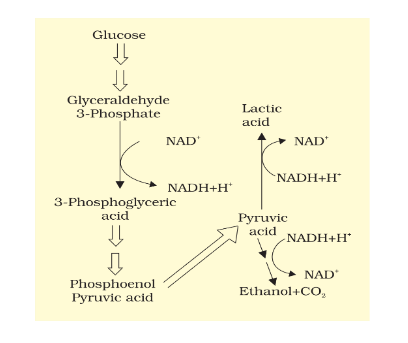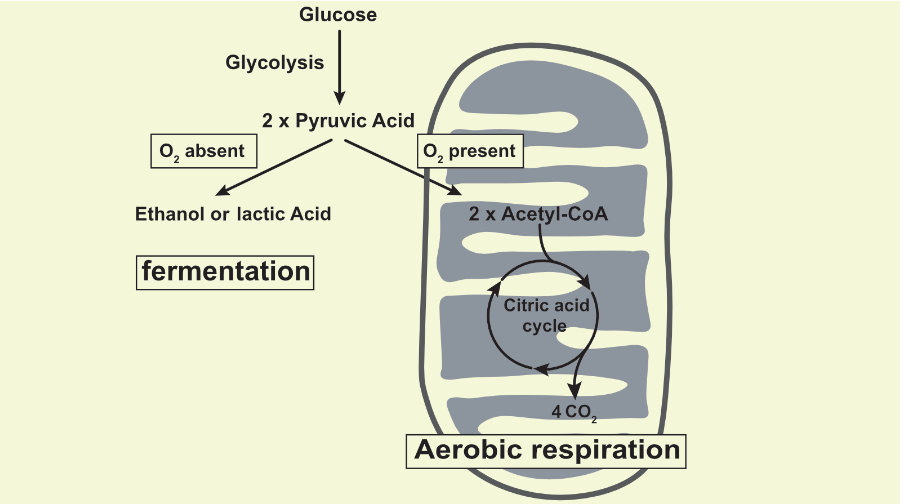Table of Contents
Introduction to respiration
Respiration is the process by which living organisms convert organic molecules into usable energy. In aerobic respiration, oxygen is utilized to break down organic substances, mostly glucose, generating carbon dioxide, water, and ATP. It partially occurs in the cytoplasm and partially in the mitochondria of cells. Anaerobic respiration occurs in the absence of oxygen, and although it produces less ATP, it allows for energy production in low-oxygen environments. Cellular respiration is crucial for the survival and functioning of organisms, providing the energy needed for various biological processes, including growth, movement, and reproduction. It is a fundamental metabolic process found in animals, plants, and many microorganisms.
Definition of Respiration
Respiration is the biological process through which organisms convert various organic substances, including glucose, fatty acids, and amino acids, into energy. Respiration is essential for sustaining life and supporting cellular functions, growth, and reproduction in living organisms.
Types of Respiration
There are mainly two types of respiration: Aerobic respiration and anaerobic respiration.
Aerobic respiration is the process by which organisms break down organic molecules, such as glucose, in the presence of oxygen to produce energy, carbon dioxide, and water.
Anaerobic respiration, in the absence of oxygen, occurs through processes like alcoholic fermentation or lactic acid fermentation. While anaerobic respiration is less efficient and yields less ATP, it enables energy production in oxygen-deprived conditions. However, it produces by-products like lactic acid or ethanol, which can be toxic in high concentrations.
Common Respiratory Pathway
Glycolysis is the initial step in both aerobic and anaerobic respiration, where glucose is partially broken down in the cytoplasm of cells to generate energy in the form of ATP. This process occurs in all living organisms, from bacteria to humans. During glycolysis, a single molecule of glucose (a 6-carbon compound) is converted into two molecules of pyruvate (a 3-carbon compound).
The overall process of glycolysis can be summarised in two phases:
- Energy Investment Phase: Two ATP molecules are utilized to activate glucose, which is then split into two three-carbon molecules called glyceraldehyde 3-phosphate (G3P).
- Energy Harvesting Phase: Each G3P molecule is oxidized and phosphorylated, resulting in the production of two molecules of NADH and four molecules of ATP. Additionally, the G3P is rearranged to form pyruvate.
At the end of glycolysis, two molecules of pyruvate, two molecules of NADH are produced, with net gain of two ATP molecules. The NADH can be further utilised in subsequent stages of aerobic respiration to generate additional ATP.
Overall, glycolysis is a fundamental metabolic pathway that provides a quick source of energy by breaking down glucose (most common respiratory substrate) into smaller molecules in both aerobic and anaerobic respiration.
Anaerobic Respiration
Types of Anaerobic Respiration
Lactic acid fermentation
It occurs in certain microorganisms, as well as in muscle cells during intense exercise. In this process, pyruvate, the end product of glycolysis, is converted into lactic acid. This conversion regenerates the supply of NAD+ required for glycolysis to continue.
During lactic acid fermentation, the NADH produced in glycolysis donates its high-energy electrons to pyruvate, converting it into lactic acid. This reaction occurs in the cytoplasm of cells. Lactic acid fermentation is an important process in the dairy industry to produce yogurt, cheese, and other fermented dairy products. It is also responsible for the buildup of lactic acid in muscles during strenuous exercise, leading to muscle fatigue and soreness.
Alcoholic fermentation
It is another type of anaerobic respiration that occurs in certain microorganisms, including yeast. It involves the conversion of pyruvate into ethanol and carbon dioxide. This process is utilized in the production of alcoholic beverages, such as beer, wine, and spirits. Yeast cells consume glucose and produce ethanol and carbon dioxide as byproducts.
In alcoholic fermentation, pyruvate is first converted into acetaldehyde, which then accepts the electrons from NADH, converting it back into NAD+. The acetaldehyde is further reduced by accepting additional electrons, resulting in the production of ethanol. The carbon dioxide released during this process contributes to the carbonation in beverages.
Both lactate fermentation and alcoholic fermentation are essential in anaerobic environments where oxygen is limited or absent. While these processes are less efficient in terms of ATP production compared to aerobic respiration, they allow cells and organisms to continue generating energy in oxygen-deprived conditions.

Aerobic Respiration
After glycolysis, if oxygen is available then the cells can perform aerobic respiration.
Link Reaction
Glycolysis is followed by link reaction. The link reaction, also known as the pyruvate decarboxylation, is a metabolic pathway that occurs in the mitochondria. It converts pyruvate, a product of glycolysis, into acetyl-CoA, releasing carbon dioxide and generating NADH in the process. The acetyl-CoA then enters the citric acid cycle for further energy production.
Krebs Cycle
After glycolysis, if oxygen is available, pyruvate generated in the cytoplasm moves into the mitochondria. Within the mitochondrial matrix, each pyruvate molecule undergoes a series of reactions called the Krebs cycle. During the Krebs cycle, each pyruvate is fully oxidized, releasing carbon dioxide and generating high-energy electron carriers (NADH and FADH2). The cycle also produces a small amount of ATP.
Oxidative Phosphorylation
The electron carriers (NADH and FADH2) generated in glycolysis and the Krebs cycle donate their electrons to the electron transport chain, which is embedded in the inner mitochondrial membrane. The electron transport chain consists of a series of protein complexes that shuttle electrons down the chain, releasing energy in the process. This energy is used to pump hydrogen ions (protons) across the inner mitochondrial membrane, creating an electrochemical gradient. Finally, oxygen acts as the final electron acceptor, combining electrons and hydrogen ions to form water. The flow of protons back across the membrane through ATP synthase generates ATP in a process called oxidative phosphorylation.

Frequently Asked Questions on Respiration
What is meant by aerobic respiration?
Aerobic respiration is a metabolic process that occurs in the presence of oxygen. It involves the breakdown of organic molecules, such as glucose, to produce energy in the form of ATP. It consists of three main stages: glycolysis which occurs in cytoplasm, the citric acid cycle, and oxidative phosphorylation, which takes place in the mitochondria.
What are the products of aerobic respiration?
The end products of aerobic respiration are carbon dioxide (CO2.), water (H2O), and energy in the form of adenosine triphosphate (ATP), 38 molecules which is generated through oxidative phosphorylation.
What are the different types of aerobic organisms?
There are several different types of aerobes, which are organisms that require oxygen for their metabolic processes. Some common examples of aerobes include: Obligate aerobes: These organisms can only survive and grow in the presence of oxygen. They rely on aerobic respiration to generate energy. Facultative anaerobes: These organisms can switch between aerobic and anaerobic respiration depending on the availability of oxygen. They can survive in the presence or absence of oxygen, but their growth is usually better in aerobic conditions. Facultative aerobes: These organisms can switch between aerobic and anaerobic respiration depending on the availability of oxygen. They can survive in the presence or absence of oxygen, but they prefer anaerobic conditions.
What is the formula for aerobic respiration?
The balanced chemical formula for aerobic respiration is: C6H12O6 (glucose) + 6O2 (oxygen) → 6CO2 (carbon dioxide) + 6H2O (water) + energy (in the form of ATP).
What is the site for glycolysis and Kreb’s cycle in eukaryotes?
The site for glycolysis in eukaryotes is cytoplasm and the site for Kreb's cycle is the mitochondrial matrix.








